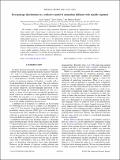First-passage distributions in a collective model of anomalous diffusion with tunable exponent
Author(s)
Amitai, Assaf; Kantor, Yacov; Kardar, Mehran
DownloadAmitai-2010-First-passage distributions in a collective model of anomalous diffusion with tunable exponent.pdf (426.5Kb)
PUBLISHER_POLICY
Publisher Policy
Article is made available in accordance with the publisher's policy and may be subject to US copyright law. Please refer to the publisher's site for terms of use.
Terms of use
Metadata
Show full item recordAbstract
We consider a model system in which anomalous diffusion is generated by superposition of underlying linear modes with a broad range of relaxation times. In the language of Gaussian polymers, our model corresponds to Rouse (Fourier) modes whose friction coefficients scale as wave number to the power 2−z. A single (tagged) monomer then executes subdiffusion over a broad range of time scales, and its mean square displacement increases as t[superscript α] with α=1/z. To demonstrate nontrivial aspects of the model, we numerically study the absorption of the tagged particle in one dimension near an absorbing boundary or in the interval between two such boundaries. We obtain absorption probability densities as a function of time, as well as the position-dependent distribution for unabsorbed particles, at several values of α. Each of these properties has features characterized by exponents that depend on α. Characteristic distributions found for different values of α have similar qualitative features, but are not simply related quantitatively. Comparison of the motion of translocation coordinate of a polymer moving through a pore in a membrane with the diffusing tagged monomer with identical α also reveals quantitative differences.
Date issued
2010-01Department
Massachusetts Institute of Technology. Department of PhysicsJournal
Physical Review E
Publisher
American Physical Society
Citation
Amitai, Assaf, Yacov Kantor, and Mehran Kardar. “First-passage distributions in a collective model of anomalous diffusion with tunable exponent.” Physical Review E 81.1 (2010): 011107. © 2010 The American Physical Society
Version: Final published version
ISSN
1539-3755
1550-2376